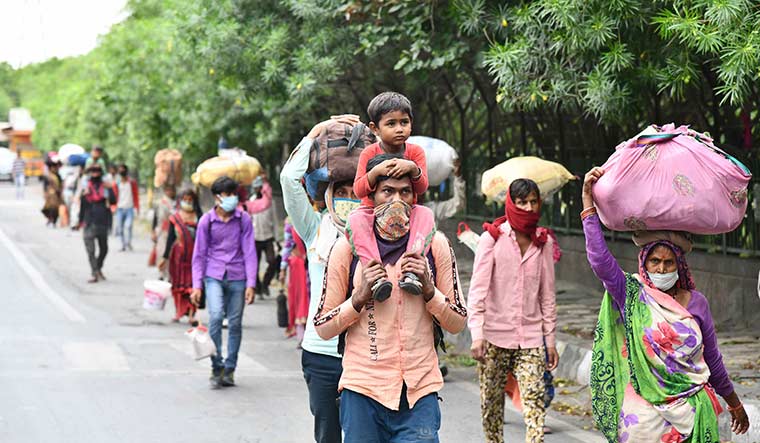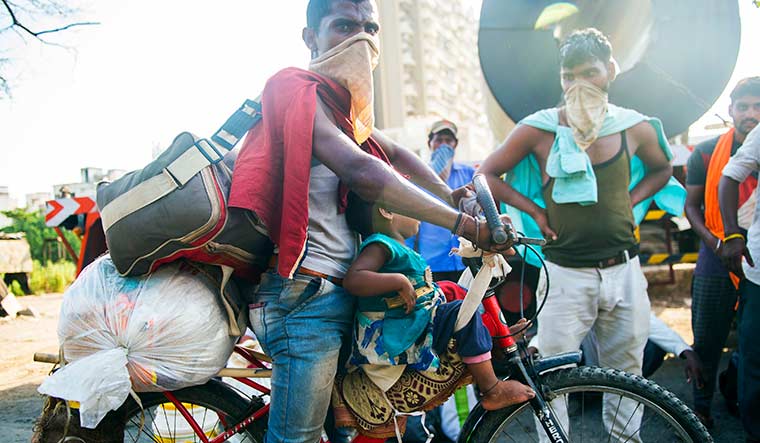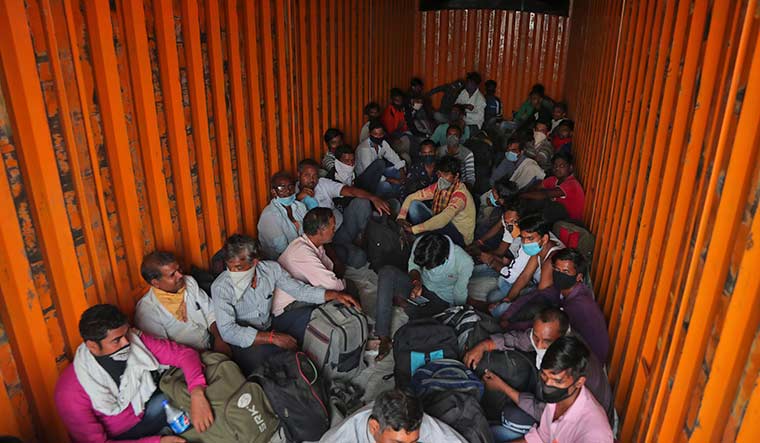JOGINDER PAL never thought he would have to go back. He had come to Delhi 18 years ago, escaping the drought-hit Banda district in Uttar Pradesh. In the capital, he found work as a painter, got married and had two children.
Then came 2020. His work was hit twice. First came the Delhi riots, and then the lockdown. Exasperated, he returned home. “I don’t know when I will come back,” he said.
With no jobs, paucity of ration and disease-induced fear, migrant workers started returning to their villages on March 25, the first day of the lockdown. Despite government assurances, the workers started their journeys, mostly on foot.
The government belatedly started special trains for workers across the country. These carried more than five lakh people in the first 10 days of operation. Of the 363 trains, till May 11, the maximum were to Uttar Pradesh (172), followed by Bihar (100), Madhya Pradesh (30), Odisha (25) and Jharkhand (22). Now, the home ministry has asked the railways to run at least 100 trains every day, each carrying 1,700 workers home.
Migrants make up more than 40 per cent of Delhi’s population. Overall, the metros have been the worst hit, and millions like Joginder realise this. The political class and the bureaucracy were taken by surprise when the migrants left the impersonal, often cruel, urban spaces to find solace in their villages.
“Migrants get economic security in the city and social security—of the family and of public assistance—in their villages,” said Chinmay Tumbe, assistant professor, IIM Ahmedabad. “Instant flight occurs when economic security vanishes and migrants seek social security.”
The Economic Survey 2017, for the first time, enumerated Railways data (2011-2016), which showed an annual average flow of close to 90 lakh migrants between states.
“The government should have done towards March end, as we argued then, what it is doing now,” said Partha Mukhopadhyay, senior fellow, Centre for Policy Research, Delhi. “The migrant workers were put in camps after the lockdown. So they could have been moved to their homes in buses, camp by camp. Perhaps, the thinking was that the lockdown would be shorter, and moving them would be costly. They are now doing it six weeks too late. Instead of spreading it over time in an organised manner, now they are trying to hurry it up. This actually increases the chances of infection, because of the mixing of groups.”
What this crisis has revealed is that government assurances did not work, and there were huge gaps in the communication strategy, which appeared to be more focussed on the middle class than the poor.
“The government did not have that big a role,” said Bharatiya Mazdoor Sangh general secretary Virjesh Upadhyay. “It is the social actors who could have convinced the migrants to stay. It was the role of NGOs and politicians of all parties to engage with the migrants and provide relief. This migration was a result of this emotional urge to go home, and the provocation generated by certain forces.”
Most migrants who move from one place to another, like construction workers, are not voters at the place of their employment, and thus seldom a pressure group for politicians. So, with the crisis hitting their livelihoods, they chose to vote with their feet.
The lack of institutional support has increased their pain. When lockdown was imposed, Sumati Devi found herself stranded in crowded Tughlakabad in Delhi, next to a containment zone. Her husband was back in Durgapur, West Bengal, and her son, a mason, was in Ernakulam, Kerala. Though she had worked in Delhi for several years, she did not have a bank account there. And hence, she could not get the benefits of Central schemes. Had she been at her native place, she could have got foodgrain under the public distribution system. This is the primary reason migrants are returning; the access to Central and state government schemes is mostly limited to their places of permanent residence.
“Another thing we saw in the migration crisis was that people moved out as they were living in inhuman conditions,” said Rathin Roy, former member of the prime minister’s economic advisory council. “That was a big lesson. We need to see bulk of industry and economic activity in areas where the majority of migrants live. Their livelihoods have to be created there.”
He also suggested that the government should focus on building slum-free areas through massive, affordable housing programmes for migrants. “It is morally unacceptable for India to be the slum capital of the world,” he said.
As of now, the states that provide the bulk of these migrant workers have their work cut out. Take, for instance, Bihar. Most of the returning migrants are first put in quarantine centres set up across the state, and are allowed to go home after 14 days. According to official figures, more than 25 lakh migrant workers have registered on the state government app to get the Rs1,000 that Chief Minister Nitish Kumar had announced. “Since April, we have created over one lakh job cards,” said Arvind Kumar Chaudhary, principal secretary, rural development department. “We created these cards in the quarantine camps they (migrants) were housed. We knew this demand would come. There is a lot of work available in infrastructure projects, like building roads, toilets and rural housing, through which we can employ around 15 lakh people. Currently, we have nine lakh registered MNREGA workers. The state will now do skill mapping of the migrants, who can then be allotted a suitable job.”
Uttar Pradesh is aiming higher. It is trying to woo foreign investors who may be looking for an alternative to China. The state has set up a desk to deal with queries from foreign investors, and there have already been some meetings. “This will create jobs and employment avenues,” said Sidharth Nath Singh, state micro, small and medium enterprises minister.
However, in this bid to grow, some states have decided to amend labour laws, which would, depending on the state, bring in changes like—an increase in working hours to 12 a day to a rise in productivity without interference from labour inspectors. The BJP-ruled states of Uttar Pradesh, Gujarat and Madhya Pradesh have been particularly bold in this regard, and the reforms are expected to generate political acrimony in the coming days.
“The country has seen an inhuman spectacle unfold as workers were given only four hours before the lockdown by the Modi government,” said Congress spokesperson Shaktisinh Gohil. “They were forced to walk for food and shelter. Then they were hit by another jolt. Labour laws were removed as the government wanted to give a red-carpet welcome to foreign investors.”
Left and Congress trade unions have decided to approach the International Labour Organization against the move. “Most of the states ruled by the BJP and its allies are competing with others in the name of development and attracting investment,” said Tapan Sen, general secretary, Centre of Indian Trade Unions. “An inhuman crime is being committed.”
Added Upadhyay: “We will fight the dilution through all democratic means. The governments should not replicate the China model of bypassing labour laws as it does not follow democratic traditions.”
The Centre’s strategy is clear. It is promoting domestic manufacturing as a counter to China. But a boom in manufacturing results in large-scale movement of labour. The government would have to look into the needs of the migrants when they promote manufacturing.
Defending the labour reforms, Gopal Krishna Agarwal, BJP spokesperson and an expert on economic affairs, said that most of the manufacturing industry had adequate labour to start factories, but there was no demand as markets are shut. “Look at Haryana,” he said. “It has created a website for labourers who want to return for work, and many have already registered.”
Said Sidharth Nath Singh: “As a result of reforms in labour laws in Uttar Pradesh, new employment opportunities as well as investment from foreign companies will come to the state.” The Uttar Pradesh government has already set a target to create 15 lakh jobs, while ramping up jobs under MNREGA from 20 lakh a day to 50 lakh daily.
The industry is looking for opportunities to expand in areas where there is ready availability of labour. “The lockdown has provided an opportunity for industries to assess the benefits of moving to areas where the migrant workers are from,” said Vikram Kirloskar, president, Confederation of Indian Industry. “We cannot have health without the economy and the economy without health. Therefore, we need flexibility and safeguards with labour laws being relooked at.”
The shortage of workers will hurt the industry for some time, but the workers cannot stay in their villages for long. “The migrants will be economically compelled to return as they would have few sources of employment at their native places, and hardly any reasonable living standards,” said Mukhopadhyay, who chaired a committee on migration set up by the ministry of housing and urban affairs. “The highly skilled migrants may hold on a bit longer to return as their experience with this process was not particularly positive. But what you see in China, is that it is not clear if jobs will be there at all. So, the workers are more likely to come back if there is some assurance about the jobs available.”
The committee he headed had recommended portability of the ration card, which the Centre is doing under its ‘One Nation, One Ration Card’ scheme. “We had also recommended that the government set up a register of migrants,” he said. “The government now has the data as it moved so many migrants into camps and have been documented for relief, for travel and for testing. This data can be used to give social benefits.”
The Economic Survey 2017 had shown new trends in migration. “Internal migration rates have dipped in Maharashtra and surged in Tamil Nadu and Kerala, reflecting the growing pull of southern states in India’s migration dynamics, as the southern states created more facilities for the migrants,” it said. “Thus, also proving that language was no longer a barrier in migration for work.”




